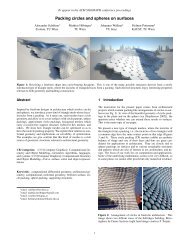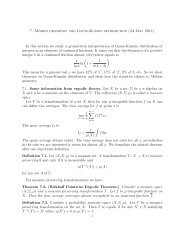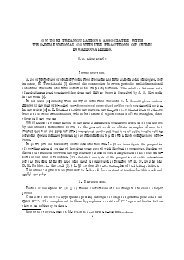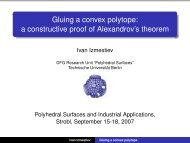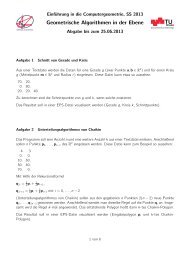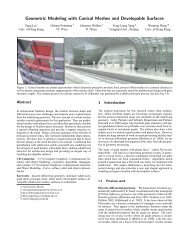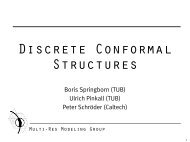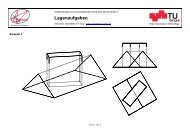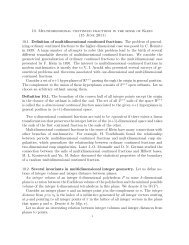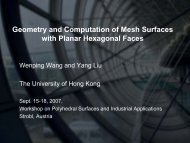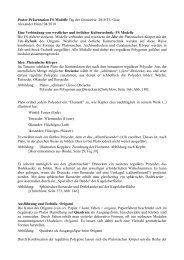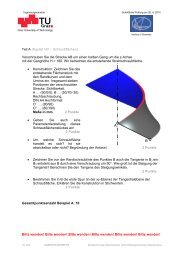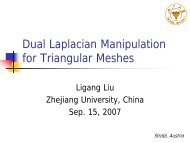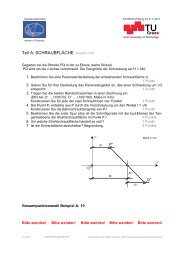Car Side Window Kinematics - Institute of Geometry - Graz ...
Car Side Window Kinematics - Institute of Geometry - Graz ...
Car Side Window Kinematics - Institute of Geometry - Graz ...
You also want an ePaper? Increase the reach of your titles
YUMPU automatically turns print PDFs into web optimized ePapers that Google loves.
<strong>Car</strong> <strong>Side</strong> <strong>Window</strong> <strong>Kinematics</strong><br />
A. Gfrerrer a , J. Lang a , A. Harrich b , M. Hirz b , J. Mayr b<br />
a <strong>Institute</strong> <strong>of</strong> <strong>Geometry</strong>, <strong>Graz</strong> University <strong>of</strong> Technology, Austria<br />
b <strong>Institute</strong> <strong>of</strong> Automotive Engineering, <strong>Graz</strong> University <strong>of</strong> Technology, Austria<br />
Abstract<br />
It is a demanding and time-consuming task to construct the side window<br />
mechanism <strong>of</strong> a car such that the deflections along the seals are minimized.<br />
The reason for this is that the window surface S delivered by the stylist, will<br />
in general not be movable in a proper way: It is required that the surface<br />
tightly moves along the seals. Deflections will necessarily occur no matter<br />
how much effort the engineer invests. This article describes how to find<br />
a spatial motion that minimizes seal deflection for some given automobile<br />
side window surface. Necessary but acceptable modification <strong>of</strong> the stylist’s<br />
surface S is also addressed, as well as the lifting mechanism design. It is<br />
argued that our systematic approach <strong>of</strong>fers considerable savings compared to<br />
the prevailing trial-and-error approach.<br />
Keywords:<br />
space kinematics, car side window, window lifter mechanism<br />
1. Introduction<br />
Development <strong>of</strong> modern automotive products and systems is characterized<br />
by accelerated production cycles, product diversification and quality<br />
enhancement. Use <strong>of</strong> integrated virtual development methods that combine<br />
design, simulation and product management are continually sought. Fig.<br />
1 shows the automotive door development process in the conceptual phase.<br />
One major input is the car body styling. The styling data are transferred to<br />
the computer aided engineering tools which, in turn, define a door concept<br />
by iterative processes.<br />
Email addresses: gfrerrer@tugraz.at (A. Gfrerrer), johann.lang@tugraz.at (J.<br />
Lang), alexander.harrich@tugraz.at (A. Harrich), mario.hirz@tugraz.at (M. Hirz),<br />
johannes.mayr@tugraz.at (J. Mayr)<br />
Preprint submitted to CAD January 10, 2011
Styling<br />
Door type<br />
Ergonomics<br />
& comfortf t<br />
Door gap<br />
s<br />
t modules<br />
Project<br />
Turn in kinematics<br />
<strong>Window</strong> kinematics<br />
Se<br />
ealing concept<br />
Concept geometry<br />
Package<br />
Project duration<br />
Structural<br />
optimization<br />
Figure 1: Exemplary automotive door development process in the conceptual phase<br />
Boundary conditions defined by the car styling interact with various<br />
engineering-based tasks. Ergonomic studies regarding the entrance area, the<br />
seat position and door opening functionalities intimately interact with the<br />
outer- (and later on with inner-) shape specifications <strong>of</strong> the door and its<br />
neighboring components. The development <strong>of</strong> the door gap goes hand in<br />
hand with a turn-in analysis and the hinge axis definition. <strong>Window</strong> kinematics<br />
is a challenging door development problem.<br />
Fig. 2 is a symbolic overview <strong>of</strong> the window kinematics layout process<br />
including the main working packages and the data flow. The details <strong>of</strong> this<br />
job are the main part <strong>of</strong> this paper.<br />
Optimizing the layout <strong>of</strong> the window kinematics requires computations<br />
not supported by commercially available CAD systems. Specific geometry<br />
based data are exported into some CAD-external computation s<strong>of</strong>tware. This<br />
includes normals <strong>of</strong> a given window surface S as well as the B-pillar curve b,<br />
the ro<strong>of</strong> curve c and the daylight curve d (see Fig. 3).<br />
The data are used to compute an optimized screw motion M <strong>of</strong> the given<br />
window surface and an additional optimal window surface proposal S M . <strong>Window</strong><br />
lifter geometry is developed in a subsequent step. To this end two appropriate<br />
anchor points Q, R are specified. The results are reimported to<br />
2
CAD<br />
• Styling surface<br />
• Concept geometry<br />
• Door packaging<br />
Export <strong>of</strong> geometry<br />
information (S, b, , c, d, Q, R)<br />
Import <strong>of</strong> calculation<br />
results (a, p,<br />
S M , r)<br />
CAD-external t lcalculation<br />
l l • Screw motion M<br />
• Surface proposal S M<br />
• Lifter rail guide radius r<br />
Figure 2: <strong>Car</strong> side window kinematics layout process<br />
the CAD system and integrated into the conceptual door model to control<br />
the corresponding geometries. Within the design process the window kinematics<br />
can be evaluated in terms <strong>of</strong> its feasibility, packaging, function and<br />
production.<br />
Figure 3: A car side window S and its boundary curves d (daylight curve), b (boundary<br />
curve towards the B-pillar) and c (ro<strong>of</strong> curve).<br />
In olden days cars had planar windows. <strong>Side</strong> windows moved vertically<br />
and all points went in straight lines. Today, readily produced, curved car<br />
windows contribute to strength, aesthetic and aerodynamic enhancement.<br />
Of course a car window is basically a solid, bounded by a surface (exte-<br />
3
ior boundary surface) and its <strong>of</strong>fset surface (interior boundary surface) at<br />
a certain distance (glass thickness). Additionally it is understood that the<br />
window sheet is bounded all around. In the following we consider a surface<br />
patch called S representing the exterior boundary <strong>of</strong> the window pane.<br />
The geometry <strong>of</strong> a car side window is mainly driven by styling considerations.<br />
The proposed window surface S is delivered by the stylist. It is the<br />
engineer’s job to design an appropriate window lifting mechanism. The main<br />
restriction is that the window has to be moved ‘in itself’. Implications <strong>of</strong> this<br />
will be explained in Section 2. It is highly unlikely that a surface S delivered<br />
by the stylist incidentally has this property. The engineer’s problem is virtually<br />
unsolvable. However, small deflections, within limits, are acceptable. It<br />
may be possible to find a motion which moves the surface S approximately<br />
in itself.<br />
Our approach follows the method suggested in [1], also applied in [2] and<br />
[3]. In contrast to [1] we not only consider the given window surface S, but<br />
also a curve b which eventually has to become a trajectory <strong>of</strong> the window<br />
motion.<br />
Our method delivers the screw motion M (or in special cases a revolution<br />
or a translation) which best fits the given window surface S and the given<br />
trajectory b (B-pillar, Section 4). The motion is determined by its screw axis<br />
a and its pitch p. The value p in a screw motion is defined as the translatorial<br />
distance per turn. With the optimal motion M in mind we can construct a<br />
new window surface S M by subjecting the window ro<strong>of</strong> curve to the motion<br />
M. S M is a screw surface and perfectly moves in itself (Section 2). The given<br />
surface S and the surface S M share the common ro<strong>of</strong> curve. The maximum<br />
distance between S and S M is a measure <strong>of</strong> the maximum deflection along<br />
the seals <strong>of</strong> S (Section 6). This can be taken as a suitable ”figure <strong>of</strong> merit” <strong>of</strong><br />
the surface S that was proposed by the stylist. The motion M is the optimal<br />
motion to be imposed on the given screw surface S and – at the same time<br />
– to S M . M enables us to construct the optimal window lifter mechanism<br />
(inside the door body, Section 7).<br />
2. Moving Curves and Surfaces in Themselves<br />
In this section we explain the concept <strong>of</strong> ‘movability in itself’ for curves<br />
and surfaces. From a mathematical standpoint we deal with the invariant<br />
curves and surfaces <strong>of</strong> one-parameter subgroups in the six-parameter Liegroup<br />
SE(3) <strong>of</strong> Euclidean displacements.<br />
4
It is easy to understand that a straight line g can be moved in itself by a<br />
parallel translation right in the direction <strong>of</strong> g. Such a motion moves any point<br />
P on g into another point P ′ , again on the line g. The whole line remains the<br />
same even if no single point on g keeps its position. Thus straight lines are<br />
curves which can be moved in themselves. The same holds for circles where<br />
the corresponding spatial motion is a revolution about the circle axis. Apart<br />
from these two examples there is only one more type <strong>of</strong> curve to share this<br />
property: the helix (Fig. 4). It can be moved in itself by subjecting it to the<br />
corresponding screw motion.<br />
Figure 4: Straight lines, circles and helices are the only curves which can be moved in<br />
themselves.<br />
This consideration, albeit theoretical, is applicable to the boundary curve<br />
<strong>of</strong> a side window sheet, e.g. the one towards the B-pillar <strong>of</strong> a car. But we<br />
also have to pose the same question for surfaces:<br />
Which surfaces can be moved in themselves?<br />
The answer is very similar to the answer in the curve case: There are three<br />
types belonging to parallel translations, revolutions and screw motions. The<br />
types are (Fig. 5)<br />
• cylinder surfaces, generated by a curve being subjected to a parallel<br />
translation.<br />
• surfaces <strong>of</strong> revolution, generated by a curve subjected to a revolution<br />
about an axis.<br />
• screw surfaces, generated by a curve subjected to a screw motion.<br />
5
Figure 5: Cylinders, surfaces <strong>of</strong> revolution and screw surfaces are the only surfaces which<br />
can be moved in themselves.<br />
In a way, the first two items can be viewed as special cases <strong>of</strong> the latter.<br />
A rotation is a screw motion where the pitch vanishes, whereas a parallel<br />
translation is the limit case <strong>of</strong> a screw motion where the pitch approaches<br />
infinity. In these terms we can state:<br />
Any window sheet moving in itself necessarily is a screw surface.<br />
3. Preliminaries from Line <strong>Geometry</strong><br />
In the following we recall some well-known facts from line geometry which<br />
we will need further on. For pro<strong>of</strong>s and further details see [4, Chapter 3].<br />
A straight line g in 3-space can be determined by its six ‘Plücker coordinates’<br />
g 1 , g 2 , g 3 , g 1 , g 2 , g 3 .<br />
These six numbers are usually collected in two 3-dimensional vectors<br />
⎡ ⎤ ⎡ ⎤<br />
g 1<br />
g 1<br />
g = ⎣ g 2<br />
⎦ , g = ⎣ g 2<br />
⎦ ,<br />
g 3 g 3<br />
called ‘normalized Plücker vectors’ <strong>of</strong> g. The term ‘normalized’ indicates that<br />
the first Plücker vector g is <strong>of</strong> norm 1. The Plücker vectors <strong>of</strong> a line g can<br />
be computed as follows: If g is a line with normalized direction vector d and<br />
containing the point P whose position vector is p then<br />
g = d,<br />
g = p × d.<br />
6
Due to this definition the Plücker vectors g, g <strong>of</strong> a straight line g have the<br />
following properties:<br />
• The components <strong>of</strong> g and g always satisfy the homogeneous quadratic<br />
equation<br />
Q : 〈g, g〉 = g 1 · g 1 + g 2 · g 2 + g 3 · g 3 = 0, (1)<br />
called Plücker property. Here 〈., .〉 denotes the standard scalar product<br />
<strong>of</strong> two vectors.<br />
• Since g = d is a normalized direction vector <strong>of</strong> g we have<br />
Q ∗ : 〈g, g〉 = g 2 1 + g 2 2 + g 2 3 = 1. (2)<br />
• Replacing the point P ∈ g by another point Q ∈ g does not change the<br />
second Plücker vector g <strong>of</strong> g.<br />
By interpreting the Plücker coordinates g 1 , g 2 , g 3 , g 1 , g 2 , g 3 as coordinates<br />
<strong>of</strong> a point G in the six-dimensional space R 6 we obtain a mapping<br />
κ : g −→ G = κ(g)<br />
from the set <strong>of</strong> oriented lines in 3-space to a set <strong>of</strong> points in R 6 (also compare<br />
with [3]). As the coordinates g 1 , g 2 , g 3 , g 1 , g 2 , g 3 have to satisfy (1) and (2)<br />
the image points G lie in the intersection G <strong>of</strong> the two quadratic surfaces Q<br />
and Q ∗ in R 6 determined by these two equations:<br />
• Q in Eq. (1) is a quadratic cone whose vertex lies in the coordinate<br />
system origin.<br />
• Q ∗ in Eq. (2) is a quadratic cylinder with 3-dimensional generator<br />
spaces.<br />
The four-dimensional intersection manifold G = Q∩Q ∗ is algebraic <strong>of</strong> degree<br />
four.<br />
Conversely, each point G ∈ G represents a uniquely determined oriented<br />
line g in 3-space as follows:<br />
Let g 1 , g 2 , g 3 , g 1 , g 2 , g 3 be the coordinates <strong>of</strong> G. After having put g :=<br />
[g 1 , g 2 , g 3 ] ⊤ , g := [g 1 , g 2 , g 3 ] ⊤ the (normalized) direction vector <strong>of</strong> the line g<br />
is<br />
d = g,<br />
7
whereas<br />
p = g × g<br />
is the position vector <strong>of</strong> a point P on g. By the way: P is the pedal point<br />
on g w.r.t. the chosen origin.<br />
As a conclusion we have that the mapping κ between the set <strong>of</strong> oriented<br />
lines in 3-space and the set <strong>of</strong> points on the manifold G is a bijection.<br />
Let now M denote a screw motion (or, as a special case, a pure rotation<br />
or a pure translation). We consider the tangents <strong>of</strong> the paths generated by<br />
M. They establish a vector field which can be written in the form:<br />
ṗ = w × p + v<br />
where v = [v 1 , v 2 , v 3 ] ⊤ , w = [w 1 , w 2 , w 3 ] ⊤ are constant vectors and ṗ denotes<br />
the tangent vector <strong>of</strong> the point P with position vector p = [p 1 , p 2 , p 3 ] ⊤ (see,<br />
for instance [5, p. 25]).<br />
More precisely we have:<br />
• M is a true screw motion if and only if w ≠ [0, 0, 0] ⊤ and 〈w, v〉 ≠ 0.<br />
In this case<br />
〈w, v〉<br />
p = 2π<br />
〈w, w〉<br />
(3)<br />
is the pitch <strong>of</strong> M,<br />
d = w (4)<br />
is a direction vector <strong>of</strong> the screw axis a and<br />
a = w × v<br />
〈w, w〉<br />
(5)<br />
is a position vector <strong>of</strong> a point A ∈ a.<br />
• M is a rotation if and only if w ≠ [0, 0, 0] ⊤ but 〈w, v〉 = 0. Again the<br />
axis <strong>of</strong> the rotation is determined just as in the screw motion case.<br />
• The motion M is a translation (parallel to v) if and only if w =<br />
[0, 0, 0] ⊤ .<br />
8
Let g be a line orthogonal to the path c P (<strong>of</strong> a point P ) w.r.t. the motion<br />
M. Then we obtain<br />
0 = 〈ṗ, g〉 = 〈w × p + v, g〉 = det(w, p, g) + 〈v, g〉<br />
= 〈w, p × g〉 + 〈v, g〉 = 〈w, g〉 + 〈v, g〉,<br />
where g, g denote the Plücker vectors <strong>of</strong> g. Thus, the condition<br />
〈v, g〉 + 〈w, g〉 = 0 (6)<br />
characterizes the set <strong>of</strong> path normals <strong>of</strong> the motion M.<br />
Eq. (6) is linear and homogeneous in the Plücker coordinates. Therefore,<br />
interpreting this condition in the six-dimensional space R 6 , we have that the<br />
point G = κ(g) lies in a hyperplane H O passing through the origin O.<br />
The important conclusion is:<br />
If we want to find a screw motion such that a given straight line g belongs<br />
to its path normals, we have to look for a hyperplane H O <strong>of</strong> R 6 through the<br />
origin containing the κ-image G = κ(g) <strong>of</strong> g.<br />
Such a hyperplane in R 6 is determined by 5 points G 1 , . . . , G 5 in general<br />
position (Fig. 6). Hence, in general we can find exactly one screw motion<br />
(including the special cases mentioned above) to a set <strong>of</strong> five given lines<br />
g 1 , . . . , g 5 as path normals.<br />
Figure 6: The κ-images G i and hyperplane H O containing them.<br />
Definition: The set <strong>of</strong> path normals <strong>of</strong> a screw motion M is called a<br />
linear complex. It is denoted by L M .<br />
4. Computing the optimal screw motion.<br />
The method which we are following in this section has been suggested<br />
in [1] and it has also been applied in [2] and [3]. If a surface S is moved in<br />
9
itself, any point P ∈ S follows a path c P ⊂ S. This implies that the tangent<br />
t P <strong>of</strong> c P is orthogonal to the surface normal n P . We are looking for some<br />
screw motion M; so each surface normal n P is a path normal <strong>of</strong> M and thus<br />
belongs to the line complex L M .<br />
Let us return to the side window matter: In our case we have a set <strong>of</strong><br />
surface normals g i , i = 1, . . . n which are path normals to the screw motion<br />
we are determined to find (Fig. 7, left). The κ-images G i = κ(g i ), i = 1, . . . n<br />
<strong>of</strong> those normals form a ‘point cloud’ (Fig. 7, right). If we are given more<br />
than five normals g (n > 5) under real-life conditions it is unlikely that the<br />
corresponding point cloud lies exactly within one hyperplane H O through<br />
the origin O. What we can try is finding a hyperplane through O which best<br />
fits the point cloud, delivering the least square sum <strong>of</strong> deviations. This is the<br />
core part <strong>of</strong> the calculation, an optimization process within the 6-dimensional<br />
space R 6 . In the following we describe the single steps <strong>of</strong> this optimization<br />
routine.<br />
Figure 7: A set <strong>of</strong> surface normals {g i }, the corresponding κ-images {G i } in R 6 and the<br />
optimal hyperplane H O .<br />
Let g i , g i be the Plücker vectors <strong>of</strong> the line g i . If the points G i = κ(g i )<br />
were indeed within a hyperplane we would have<br />
〈v, g i 〉 + 〈w, g i 〉 = 0<br />
for i = 1 . . . n with some coefficient vectors v, w. For our point cloud this<br />
may not be the case.<br />
10
If [v ⊤ , w ⊤ ] ⊤ = [v 1 , v 2 , v 3 , w 1 , w 2 , w 3 ] ⊤ denotes the normalized normal vector<br />
<strong>of</strong> the yet unknown hyperplane H O , then the squared distance <strong>of</strong> the<br />
point G i to H O is computed via<br />
Hence, we have to minimize the sum<br />
d 2 i = (〈v, g i 〉 + 〈w, g i 〉) 2 .<br />
f(v, w) =<br />
n∑<br />
d 2 i (7)<br />
i=1<br />
<strong>of</strong> squared distances subject to the constraint<br />
g(v, w) = v 2 1 + v 2 2 + v 2 3 + w 2 1 + w 2 2 + w 2 3 − 1 = 0. (8)<br />
The constraint equation guarantees that the normal vector <strong>of</strong> H O has indeed<br />
length 1.<br />
Using a Lagrangian multiplier λ for this constraint leads to determining<br />
the smallest eigenvalue <strong>of</strong> a positive semidefinite 6×6-matrix. For the details<br />
the reader is referred to section 2 <strong>of</strong> [3].<br />
The outcome <strong>of</strong> the optimization process is called M. In geometrical<br />
terms M is a hyperplane through the origin O in the 6-space<br />
M . . . 〈v, g i 〉 + 〈w, g i 〉 = 0.<br />
In mathematical terms we have a 6-vector [v ⊤ , w ⊤ ] ⊤ = [v 1 , v 2 , v 3 , w 1 , w 2 , w 3 ] ⊤ .<br />
5. A prescribed path<br />
The method <strong>of</strong> [1] will now be modified by additionally considering a<br />
given input curve. The motion M we found may be the best possible motion<br />
for the given window surface. However, a side window sheet requires one<br />
more thing: There is the boundary curve b towards the B-pillar, which is<br />
prescribed. It is usually shaped as a seal slit and has to be a path <strong>of</strong> the<br />
window motion M. We obtain additional constraints for the screw motion<br />
M to be found.<br />
If each normal to b belongs to the linear complex L M we can be sure that<br />
b is moved in itself. This implies that b is a path <strong>of</strong> M, i.e., a helix.<br />
If we are given the boundary curve b it – most probably – is not a helix.<br />
We have to find a screw motion with a helical path as close to b as possible.<br />
More precisely:<br />
11
This screw motion M has to fit the window surface S and the B-pillar b<br />
at the same time.<br />
The fact that the surface normal in a point Q ∈ S belongs to the linear<br />
complex L M signifies the condition that the path <strong>of</strong> Q is tangent to S in Q.<br />
If Q belongs to the curve b we demand even more: The path tangent t Q to<br />
Q is meant to be tangent not only to the window surface S but even to the<br />
curve b ⊂ S. All the path normals to b in Q have to belong to the linear<br />
complex L M . These path normals form a pencil <strong>of</strong> straight lines (Fig. 8).<br />
Figure 8: The B-pillar b and its normals.<br />
It is sufficient to pick two lines out <strong>of</strong> this pencil <strong>of</strong> lines. Each <strong>of</strong> these two<br />
lines yields a condition which is <strong>of</strong> the same type as all the other conditions<br />
for the surface normals n P <strong>of</strong> our window. We can add the surface normal<br />
n Q in Q and one more line. The latter could be the line n ∗ Q with the direction<br />
orthogonal to both t Q and n Q .<br />
If we want to express that our motion M ought to have a trajectory ‘close<br />
to the curve b’ we have to consider several points Q ∈ b and we have to add<br />
a pair <strong>of</strong> lines for each <strong>of</strong> them. This adds up to a number <strong>of</strong> additional lines<br />
which have to belong to the linear complex L M just as the surface normals.<br />
We have a set <strong>of</strong> further conditions for our optimization problem. The task<br />
itself, however, is <strong>of</strong> the same nature and the algorithm can basically remain<br />
unchanged.<br />
Remark: In real life examples we chose 100 surface normals for the window<br />
sheet and 50 points along the curve b. Those 50 points Q delivered 50 surface<br />
normals n Q and another 50 lines n ∗ Q . So we eventually had 200 straight lines<br />
12
as the input for our optimization job. The lines yielded 200 points in the<br />
5-space and our method delivered a hyperplane to this point cloud. This<br />
hyperplane in turn symbolized a screw motion M.<br />
We have achieved a window motion which fits the B-pillar in terms <strong>of</strong><br />
moving it in itself and, at the same time, fits the window sheet as perfectly<br />
as possible.<br />
Admittedly, there is still the question: How good is ‘as perfect as possible’?<br />
This question is addressed in the next section.<br />
6. Evaluating the surface<br />
In the past the process <strong>of</strong> setting up a proper kinematic layout for a side<br />
window pane has always been a delicate job. Whatever kinematic solution the<br />
engineer brought forward, it was difficult to tell whether the flaws showing<br />
up were due to the kinematic mechanism or already inherent in the given<br />
window surface design. It is imperative to evaluate the result. To this end<br />
we have to find some figure <strong>of</strong> merit for the outcome.<br />
The screw motion M which we have found moves any screw surface (corresponding<br />
to M) perfectly in itself. One such surface which is probably<br />
pretty close to the given window sheet, could be constructed in the following<br />
way:<br />
We choose a curve c on the given window surface S. This might be any<br />
curve e.g., the daylight curve <strong>of</strong> the window. However, we suggest taking the<br />
border curve <strong>of</strong> S towards the ro<strong>of</strong> together with the border curve towards<br />
the A-pillar. We call this joint curve c the ‘ro<strong>of</strong> curve’. If we subject this<br />
curve c to the optimal screw motion M we create a screw surface S M .<br />
The surface S M has the following properties<br />
• S M moves in itself if the motion M is applied. There is no deflection<br />
whatsoever.<br />
• S M and S share the common ro<strong>of</strong> curve c.<br />
Let m be the maximum distance between S and S M . This value m is a<br />
reliable measure for the maximum deflection caused by the screw motion M<br />
if applied to the given window surface S.<br />
The value m can be compared with the deflection limits <strong>of</strong> the seals<br />
manufacturer. This way it is easy to tell whether the kinematic design is<br />
within the design target. Just in case that the deflection value m exceeds<br />
13
the limits, we have a good argument for returning the window sheet design<br />
to the stylist. We can even add a suggestion for a perfect replacement S M<br />
with the following appealing properties:<br />
• S M differs from S by a margin which nowhere exceeds the value m.<br />
• S M has the same ro<strong>of</strong> curve c as the original proposal S.<br />
• S M moves perfectly in itself.<br />
If the method is applied at an early stage <strong>of</strong> the design process this may<br />
lead to a perfect solution in the first place.<br />
Remark: For experimental validation we applied the method to an example<br />
which is already being produced, and which has already been tried and<br />
tested. We arrived at a value m being a fraction <strong>of</strong> a millimeter. Had our<br />
method been applied in the first place it would have surely avoided a lot <strong>of</strong><br />
cut-and-try.<br />
7. Constructing the lifter mechanism<br />
Fig. 9 shows the configuration <strong>of</strong> a cable actuated window lifter mechanism<br />
with two guides. This type <strong>of</strong> mechanism has a simple setup and is<br />
commonly used in automotive front doors. The sliding blocks moving the<br />
window glass are routed along the guide rails. The actuation is performed<br />
by an electric motor (formerly by a hand crank) via a Bowden cable driving<br />
the capstan.<br />
Once we know the motion M it is easy to devise a suitable mechanism.<br />
All we have to do is choose two appropriate anchor points and consider<br />
their trajectories. These curves would, theoretically, be perfect guides (rails)<br />
for the mechanism. We have to move each <strong>of</strong> the points on its respective<br />
trajectory.<br />
Of course there is always a difference between fundamental considerations<br />
and real world applications with their real world constraints. We know the<br />
window motion M is a screw motion with axis a and pitch p. A steady screw<br />
motion moves every point in space with constant speed. Points with the<br />
same speed lie on a right cylinder whose axis coincides with the screw axis a.<br />
If there is only one lifter motor it is preferable choose anchor points moving<br />
at the same speed to ensure that the lifter cable pulls equally at both rails.<br />
As we know all the details about our screw motion M we can easily<br />
see what this constraint brings about: We have to choose two points Q, R<br />
14
cable connection<br />
window surface<br />
sliding block<br />
sliding block<br />
guide rail<br />
guide rail<br />
Figure 9: Cable actuated window lifter mechanism with two guides. The dark grey mechanical<br />
component between the rails is the electric motor unit.<br />
(anchor points, see Section 1) with equal distance from a. They must lie on<br />
the same cylinder <strong>of</strong> revolution with the axis a. Of course the two points have<br />
to be located near the bottom boundary curve <strong>of</strong> the window sheet. After<br />
having selected one point the second can still be chosen on the corresponding<br />
cylinder surface about a. We merely have to ensure there is no interference<br />
within the door cavity.<br />
Screw line rails are spatially curved. Rails in the form <strong>of</strong> a planar curve<br />
are cheaper. The plane curve arc that most closely conforms to a helix is<br />
circular. If we replace an optimal helix by an appropriate circle we certainly<br />
have to accept some deviation from the ideal motion.<br />
We can easily simulate the effect <strong>of</strong> replacing the helical rails by circular<br />
ones. We choose 3 particular points P 1 , P 2 , P 3 on the helical arc and construct<br />
a circle through these 3 points. Three suitable points are shown in Fig. 10,<br />
(a).<br />
In an actual design the helical and circular arcs conform much more<br />
closely than those seen in Fig. 10, (a); to emphasize the distinction between<br />
the two arcs we intentionally display the helical arc beyond its actually used<br />
15
ange.<br />
screw line arc<br />
circular arc<br />
Q<br />
R<br />
P 1<br />
P 2 P 3<br />
(a) Choosing 3 points P 1 , P 2 , P 3 on a helical arc<br />
to find an appropriate circular approximation.<br />
(b) Two appropriate anchor<br />
points Q, R; their helical trajectories<br />
are replaced by circular<br />
arcs <strong>of</strong> equal radius.<br />
Figure 10: Replacing the helical arcs by approximating circular segments.<br />
Consider the following specific example with dimensions r (helix radius),<br />
p (pitch) and h W (window height). The values r = 2000 mm, p = 600π mm<br />
and h W = 400 mm deliver 1 a maximum difference between the helical arc<br />
and the circular arc <strong>of</strong> less than 0.05 mm. The two circular rails have the<br />
following properties:<br />
• If the two anchor points Q, R (Fig. 10, (b)) are on the same cylinder <strong>of</strong><br />
revolution about the screw axis a, the two circular arcs have the same<br />
radius.<br />
• In this case the point paths along the two rails have the same length.<br />
The motion M has the two points move with equal speed on their rails.<br />
1 These figures are approximate but realistic.<br />
16
• If the two anchor points are even on the same generator <strong>of</strong> the cylinder<br />
<strong>of</strong> revolution about a and the two circular rails are parallel.<br />
It is not necessary to locate the two anchor points on the same generator<br />
(i.e., that they lie on a line parallel to the screw axis a). To have two rails<br />
in parallel planes would not bring about any further benefits. It must be<br />
pointed out here that the engineers’ concern that locating a pair <strong>of</strong> rails<br />
in non-parallel planes would cause the mechanism to stall is unfounded. If<br />
the engineer keeps this in mind he or she certainly has one more degree <strong>of</strong><br />
freedom in designing a lifter mechanism. Considering the confined space<br />
within a door body, this may be important.<br />
8. Conclusions<br />
This article has treated the development <strong>of</strong> side window design from the<br />
initially suggested stylist’s window surface all the way to the lifter mechanism.<br />
The new method was characterized by the fact that we addressed the<br />
problem from the bottom up. We worked with the most general set <strong>of</strong> spatial<br />
motions which can move surfaces in themselves. The best motion for any<br />
given window surface was derived. Further on we checked the given window<br />
and evaluated its quality with respect to the force <strong>of</strong> friction exerted to the<br />
seals. We then constructed a proper mechanism while providing a number<br />
<strong>of</strong> free parameters such that the engineer could allow for spatial restrictions<br />
that arise in the preparation <strong>of</strong> a suitable car door design.<br />
An initial, poorly conceived window surface can be detected and then<br />
modified only slightly so as to make it compatible with free movement as<br />
well as the stylist’s original concept. There will be virtually no deflections<br />
along the seals.<br />
Hence, regardless <strong>of</strong> original window sheet suitability, there are two options.<br />
No matter which way we go, we can easily use the optimal screw<br />
motion M to construct a suitable window lifter mechanism. Replacing the<br />
helical trajectories by circular ones reduces production cost.<br />
In the development stage our approach will contribute considerable savings<br />
– and quality improvement – in the development phase <strong>of</strong> the lengthy<br />
and expensive process required to realize a new auto prototype.<br />
The procedure was first outlined at SAE World Congress 2010 in Detroit,<br />
USA [6]. Magna Steyr AG has successfully tested and applied our algorithm.<br />
We have filed for a patent [7] at Deutsches Patentamt.<br />
17
References<br />
[1] H. Pottmann, T. Randrup, Rotational and Helical Surface Approximation<br />
for Reverse Engineering, Computing 60, 1998, pp. 307–322.<br />
[2] B. Odehnal, H. Stachel, The upper talocalcanean join, Technical Report<br />
127, <strong>Geometry</strong> Preprint Series, Vienna Univ. <strong>of</strong> Technology, 2004, 12<br />
pages, http://www.geometrie.tuwien.ac.at/odehnal/knochen.pdf<br />
[3] H. Pottmann, M. H<strong>of</strong>er, B. Odehnal, J. Wallner, Line <strong>Geometry</strong> for 3D<br />
Shape Understanding and Reconstruction, in: T. Pajdla, J. Matas (Eds.),<br />
Computer Vision – ECCV 2004, Part I, Vol. 3021 <strong>of</strong> Lecture Notes in<br />
Computer Science, 1999, pp. 297–309.<br />
[4] H. Pottmann, J. Wallner, Computational Line <strong>Geometry</strong>, Springer, 2000.<br />
[5] O. Bottema, B. Roth, Theoretical <strong>Kinematics</strong>, Dover Publications, 1990.<br />
[6] A. Harrich, J. Mayr, M. Hirz, P. Rossbacher, J. Lang, A. Gfrerrer, A.<br />
Haselwanter, CAD-based synthesis <strong>of</strong> a window lifter mechanism, in: SAE<br />
World Congress, 2010, Detroit, USA.<br />
[7] A. Gfrerrer, J. Lang, M. Hirz, A. Harrich, J. Mayr, A. Haselwanter, G.<br />
Bindar, Verfahren und Vorrichtung zum Ermitteln einer Sollbewegung,<br />
zum Bewegen und zum Modifizieren eines verfahrbaren Bauteils, pat.<br />
pend. DE10 2010 003 882.2, 12.04.2010, Deutsches Patentamt.<br />
18
Authors biographies<br />
Anton Gfrerrer received the M.S. degree in mathematics and descriptive<br />
geometry from the University <strong>of</strong> <strong>Graz</strong>, <strong>Graz</strong>, Austria, in 1989 and the<br />
Ph.D. degree from <strong>Graz</strong> University <strong>of</strong> Technology (TU <strong>Graz</strong>) in 1992. He is<br />
currently an Associate Pr<strong>of</strong>essor with the <strong>Institute</strong> for <strong>Geometry</strong>, TU <strong>Graz</strong>,<br />
and also teaches at the University <strong>of</strong> Leoben. His research fields are geometry,<br />
kinematics and robotics.<br />
Johann Lang received his M.S. degree in mathematics and descriptive<br />
geometry at <strong>Graz</strong> University in 1977 and his Ph.D. degree at <strong>Graz</strong> University<br />
<strong>of</strong> Technology (TU <strong>Graz</strong>) in 1979. He is currently an Associate Pr<strong>of</strong>essor with<br />
the <strong>Institute</strong> for <strong>Geometry</strong>, TU <strong>Graz</strong>. His research fields are geometry and<br />
kinematics.<br />
Alexander Harrich was born 1982 in Klagenfurt, Austria.<br />
Education: 2005 Master’s Degree in Automotive Engineering at University<br />
<strong>of</strong> Applied Sciences FH Joanneum, <strong>Graz</strong> Job history: Since 2005 Scientific<br />
researcher at <strong>Graz</strong> University <strong>of</strong> Technology, <strong>Institute</strong> <strong>of</strong> Automotive Engineering.<br />
Research projects in the area <strong>of</strong> dynamic brake- and suspension<br />
testing (2005 - 2008). Since 2008: Doctoral student at the <strong>Institute</strong> <strong>of</strong> Automotive<br />
Engineering. Research field: Advanced design methods.<br />
Mario Hirz was born 1973 in Austria.<br />
Education: Master study <strong>of</strong> mechanical engineering and economic science at<br />
<strong>Graz</strong> University <strong>of</strong> Technology. Doctoral study at the <strong>Institute</strong> <strong>of</strong> Internal<br />
Combustion Engines and Thermodynamics.<br />
Job history: Between 2000 and 2007: Vice head <strong>of</strong> the Section Design at the<br />
<strong>Institute</strong> <strong>of</strong> Internal Combustion Engines and Thermodynamics. Since 2007:<br />
Research assistant at the <strong>Institute</strong> <strong>of</strong> Automotive Engineering. Project manager<br />
<strong>of</strong> several international engine- and vehicle research projects. Lecturer<br />
at Universities and in the automotive industry in Europe and Asia. Research<br />
activities in the area <strong>of</strong> virtual product development. About 90 publications,<br />
several national and international awards.<br />
Johannes Mayr was born 1984 in <strong>Graz</strong>, Austria.<br />
Education: Study <strong>of</strong> Mechanical Engineering and Economics, <strong>Graz</strong> University<br />
<strong>of</strong> Technology<br />
Job history: From 2005 to 2008 design engineer in the automotive industry<br />
at Magna Engineering Center. International experience in projects in Great<br />
Britain and Saudi Arabia. Since 2008 research assistant at the <strong>Institute</strong> <strong>of</strong><br />
Automotive Engineering at <strong>Graz</strong> University <strong>of</strong> Technology. Research activities<br />
in the area <strong>of</strong> 3D-CAD and development methods.<br />
19



